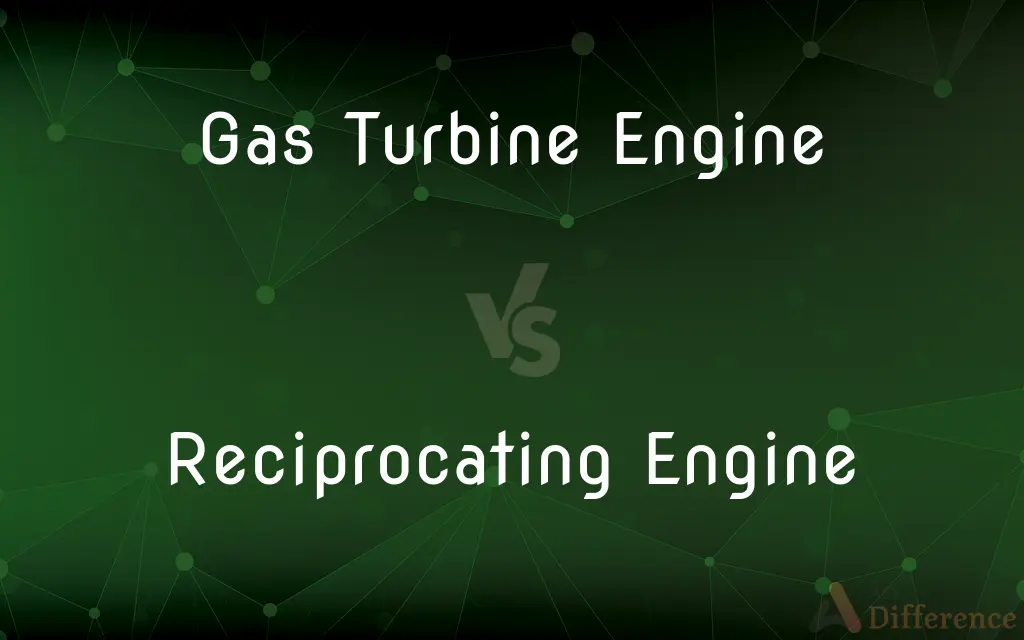Gas Turbine Engine vs. Reciprocating Engine — What's the Difference?
By Tayyaba Rehman & Fiza Rafique — Published on February 6, 2024
Gas turbine engines generate power through a continuous flow of air and combustion, ideal for high-speed applications like jets. Reciprocating engines use pistons to convert fuel into motion, common in cars.

Difference Between Gas Turbine Engine and Reciprocating Engine
Table of Contents
ADVERTISEMENT
Key Differences
Gas turbine engines operate on the principle of drawing air into a compressor, where it's mixed with fuel and ignited in a combustion chamber, producing high-velocity exhaust gases that drive a turbine and produce power. Reciprocating engines, in contrast, operate by drawing a fuel-air mixture into cylinders, where it's compressed and ignited, driving pistons back and forth to convert the fuel's energy into mechanical work.
Gas turbine engines are characterized by their high power-to-weight ratio, making them suitable for aircraft, where minimizing weight is crucial for performance and efficiency. Reciprocating engines, with their simpler design and ability to produce high torque at low speeds, are more commonly found in automobiles and small machinery.
The efficiency of gas turbine engines increases at high speeds and high power settings, which is why they are favored in aviation and power generation applications. Reciprocating engines are more efficient at lower speeds and can be more economical for everyday use in vehicles and industrial equipment.
Maintenance and operational characteristics also differ significantly; gas turbine engines typically have fewer moving parts and can be more reliable over time, but they require high-quality fuel and can be expensive to maintain. Reciprocating engines, with their more complex mechanical movements, might require more frequent maintenance but are generally easier and cheaper to repair due to their widespread use and simpler technology.
The choice between a gas turbine and a reciprocating engine depends on the application's specific requirements, including desired power output, efficiency, weight constraints, and operational costs. Each engine type offers distinct advantages and limitations, making them suited to different roles in transportation, industry, and power generation.
ADVERTISEMENT
Comparison Chart
Principle of Operation
Continuous combustion generates high-speed exhaust gases to drive a turbine.
Intermittent combustion in cylinders moves pistons.
Power-to-Weight Ratio
High, ideal for aircraft and applications where weight is critical.
Lower, suitable for ground vehicles and equipment.
Efficiency
Best at high speeds and loads, less efficient at low speeds.
More efficient at lower speeds, varies widely with load.
Maintenance
Fewer moving parts but requires high-quality fuel and maintenance.
More moving parts, generally easier and cheaper to maintain.
Typical Applications
Aviation, power generation, high-speed transport.
Automobiles, small aircraft, generators, machinery.
Compare with Definitions
Gas Turbine Engine
Gas Turbine Engine uses continuous combustion to produce thrust or power.
The jet's impressive speed is due to its advanced gas turbine engine.
Reciprocating Engine
Reciprocating Engine maintenance is generally more accessible due to widespread use.
Finding parts for the reciprocating engine was easy, thanks to its common design.
Gas Turbine Engine
Gas Turbine Engine is known for its high power-to-weight ratio.
Engineers prefer gas turbine engines for their efficiency in aircraft design.
Reciprocating Engine
Reciprocating Engine converts fuel into mechanical motion through pistons.
The old tractor's reciprocating engine rumbled to life with a distinctive sound.
Gas Turbine Engine
Gas Turbine Engine requires less maintenance due to fewer moving parts.
The gas turbine engine's reliability is attributed to its streamlined design.
Reciprocating Engine
Reciprocating Engine offers high torque at low speeds.
The truck's reciprocating engine provides the necessary torque for heavy lifting.
Gas Turbine Engine
Gas Turbine Engine operates efficiently at high speeds.
The power plant's gas turbine engine runs most efficiently at full capacity.
Reciprocating Engine
Reciprocating Engine is common in cars and small machinery.
His classic car's reciprocating engine was meticulously maintained for peak performance.
Gas Turbine Engine
Gas Turbine Engine is ideal for applications where weight and space are limited.
Spacecraft utilize gas turbine engines for their compact and lightweight advantages.
Reciprocating Engine
Reciprocating Engine is preferred for its simplicity and cost-effectiveness.
Small businesses often use equipment with reciprocating engines for their affordability.
Common Curiosities
How does a Gas Turbine Engine work?
It operates on the principle of compressing air, mixing it with fuel, igniting the mixture, and expelling the resulting high-speed exhaust gases to generate thrust.
What are the main applications of Gas Turbine Engines?
Gas Turbine Engines are commonly used in aircraft, power plants, and some marine vessels for propulsion.
What are the advantages of Gas Turbine Engines?
They offer high power-to-weight ratios, operate efficiently at high altitudes, and provide consistent performance.
Can Gas Turbine Engines run on alternative fuels?
Yes, they can run on various fuels like natural gas, biofuels, and synthetic jet fuels with appropriate modifications.
What is the typical noise level of a Gas Turbine Engine?
Gas Turbine Engines are known for their high noise levels, especially during takeoff.
What is a Reciprocating Engine?
A Reciprocating Engine is an internal combustion engine that converts linear piston motion into rotational motion to produce power.
What are the advantages of Reciprocating Engines?
They are fuel-efficient at low to moderate speeds, cost-effective for short-range applications, and easy to maintain.
Can Reciprocating Engines run on alternative fuels?
Yes, they can run on various fuels, including gasoline, diesel, natural gas, and biofuels, with appropriate adjustments.
What is a Gas Turbine Engine?
A Gas Turbine Engine, also known as a jet engine, is a type of internal combustion engine that produces thrust by expelling high-speed exhaust gases.
What are the disadvantages of Gas Turbine Engines?
They are less fuel-efficient at low speeds and less suitable for short-range applications due to higher fuel consumption.
What are the primary applications of Reciprocating Engines?
Reciprocating Engines are commonly used in automobiles, motorcycles, small aircraft, and power generators.
What are the disadvantages of Reciprocating Engines?
They have lower power-to-weight ratios, are less efficient at high altitudes, and have more moving parts, leading to higher maintenance needs.
What is the typical noise level of a Reciprocating Engine?
They are generally quieter than Gas Turbine Engines, especially at low speeds.
How do Reciprocating Engines differ from Gas Turbine Engines?
They operate by the reciprocating motion of pistons and have a different combustion process compared to the continuous flow of gas turbines.
Share Your Discovery

Previous Comparison
Life vs. Lives
Next Comparison
French Manicure vs. American ManicureAuthor Spotlight
Written by
Tayyaba RehmanTayyaba Rehman is a distinguished writer, currently serving as a primary contributor to askdifference.com. As a researcher in semantics and etymology, Tayyaba's passion for the complexity of languages and their distinctions has found a perfect home on the platform. Tayyaba delves into the intricacies of language, distinguishing between commonly confused words and phrases, thereby providing clarity for readers worldwide.
Co-written by
Fiza RafiqueFiza Rafique is a skilled content writer at AskDifference.com, where she meticulously refines and enhances written pieces. Drawing from her vast editorial expertise, Fiza ensures clarity, accuracy, and precision in every article. Passionate about language, she continually seeks to elevate the quality of content for readers worldwide.
















































